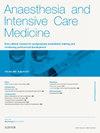General anaesthesia for operative obstetrics
IF 0.2
Q4 ANESTHESIOLOGY
引用次数: 0
Abstract
Caesarean birth remains the most performed obstetric surgical procedure globally. In the UK, though most caesarean births are performed under neuraxial anaesthesia, general anaesthesia (GA) remains the quickest option for emergency caesarean birth, and may be more appropriate for complex cases, such as those involving placenta accreta spectrum disorder. Propofol and rocuronium use for GA for caesarean birth in the UK is increasing. Whilst the evidence for routine use of videolaryngoscopy in the obstetric population is currently lacking, there is a growing interest in this, as well as the use of apnoeic oxygenation, total intravenous anaesthesia and processed electroencephalography for obstetric GA. Avoidable GA for caesarean birth may be associated with significant maternal morbidity. Training and clinical practices should continue to emphasize the identification and management of risks including aspiration, accidental awareness, and difficult or failed intubation. Carrying out simulation drills for anaesthetic emergencies, including failed intubation in patients requiring emergency caesarean birth, offers valuable insight into human factors for the multidisciplinary team, and opportunity for structured debriefing and constructive feedback.
产科手术全麻
剖腹产仍然是全球实施最多的产科外科手术。在英国,虽然大多数剖宫产是在神经轴麻醉下进行的,但全身麻醉(GA)仍然是紧急剖宫产的最快选择,并且可能更适合复杂的病例,例如涉及胎盘增生谱系障碍的病例。异丙酚和罗库溴铵在英国用于剖宫产的GA正在增加。虽然目前缺乏在产科人群中常规使用视频喉镜检查的证据,但人们对此越来越感兴趣,以及使用窒息性氧合,全静脉麻醉和处理脑电图进行产科GA。可避免的剖宫产GA可能与显著的产妇发病率相关。培训和临床实践应继续强调风险的识别和管理,包括误吸、意外意识和插管困难或失败。开展麻醉紧急情况的模拟演习,包括需要紧急剖腹产的患者插管失败,为多学科团队提供了对人为因素的宝贵见解,并有机会进行结构化的汇报和建设性的反馈。
本文章由计算机程序翻译,如有差异,请以英文原文为准。
求助全文
约1分钟内获得全文
求助全文
来源期刊

Anaesthesia and Intensive Care Medicine
ANESTHESIOLOGY-
CiteScore
0.50
自引率
0.00%
发文量
152
期刊介绍:
Anaesthesia and Intensive Care Medicine, an invaluable source of up-to-date information, with the curriculum of both the Primary and Final FRCA examinations covered over a three-year cycle. Published monthly this ever-updating text book will be an invaluable source for both trainee and experienced anaesthetists. The enthusiastic editorial board, under the guidance of two eminent and experienced series editors, ensures Anaesthesia and Intensive Care Medicine covers all the key topics in a comprehensive and authoritative manner. Articles now include learning objectives and eash issue features MCQs, facilitating self-directed learning and enabling readers at all levels to test their knowledge. Each issue is divided between basic scientific and clinical sections. The basic science articles include anatomy, physiology, pharmacology, physics and clinical measurement, while the clinical sections cover anaesthetic agents and techniques, assessment and perioperative management. Further sections cover audit, trials, statistics, ethical and legal medicine, and the management of acute and chronic pain.
 求助内容:
求助内容: 应助结果提醒方式:
应助结果提醒方式:


